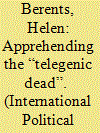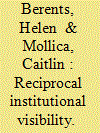| Srl | Item |
| 1 |
ID:
166758


|
|
|
|
|
| Summary/Abstract |
Images of suffering children have long been used to illustrate the violence and horror of conflict. In recent years, it is images of dead children that have garnered attention from media audiences around the world. In response to the deaths of four children killed by the Israeli army while playing on a Gazan beach, Israeli Prime Minister Netenyahu accused Hamas of generating “telegenically dead” Palestinian children for their cause (CNN 2014). In this article, it argues with this term to consider the appearance of images of dead children in global politics. I draw on a growing literature relating to the corpse as a subject in international relations (IR), asking how children's bodies are understood, following Butler, as “grievable lives.” It explores the notion of “iconic” images and the politics of sharing images of dead bodies and consider global power relations that allow certain children's deaths to be visible and not others. Through this analysis, the article argues that the idea of telegenic death might be productively considered to understand how the fleshy reality of children's deaths contribute to discussions about the representation and visibility of children in contexts of crisis and conflict.
|
|
|
|
|
|
|
|
|
|
|
|
|
|
|
|
| 2 |
ID:
172548


|
|
|
|
|
| Summary/Abstract |
In 2017 Trump expressed pity for the ‘beautiful babies’ killed in a gas attack on Khan Shaykhun in Syria before launching airstrikes against President Assad's regime. Images of suffering children in world politics are often used as a synecdoche for a broader conflict or disaster. Injured, suffering, or dead; the ways in which images of children circulate in global public discourse must be critically examined to uncover the assumptions that operate in these environments. This article explores reactions to images of children by representatives and leaders of states to trace the interconnected affective and political dimensions of these images. In contrast to attending to the expected empathetic responses prompted by images of children, this article particularly focuses on when such images prompt bellicose foreign policy decision-making. In doing this, the article forwards a way of thinking about images as contentious affective objects in international relations. The ways in which images of children's bodies and suffering are strategically deployed by politicians deserves closer scrutiny to uncover the visual politics of childhood inherent in these moments of international politics and policy-making.
|
|
|
|
|
|
|
|
|
|
|
|
|
|
|
|
| 3 |
ID:
184041


|
|
|
|
|
| Summary/Abstract |
Within the architecture of the United Nations (UN), formal recognition of the contributions of historically marginalised individuals and communities to peacebuilding denotes a positive shift in rhetoric and practice. Alongside broader institutional moves towards ‘sustaining peace’; the emergence of a ‘Youth, Peace and Security’ agenda since 2015 formalises attention to youth as positive contributors to peacebuilding and in responding to violence. This article situates the Youth, Peace and Security agenda within broader institutional and academic attention on ‘inclusive peace’. It considers the ongoing challenges in legitimising youth inclusion; and positions this emergent agenda in relation to the gains made by the Women, Peace and Security agenda, and the establishment of the UN’s sustaining peace agenda. These explorations demonstrate the value of considering the evolution of inclusive peace agendas together, while remaining mindful of their distinctive characteristics, to better understand the potential of inclusive approaches to peace. It argues that the Youth, Peace and Security agenda should be understood as a key element of shifts in UN peacebuilding practice towards inclusivity that enable visibility and legitimacy to a broader range of peace actors. We suggest that greater recognition of the contributions of youth to the broader ‘inclusive and sustaining peace’ mandates is needed.
|
|
|
|
|
|
|
|
|
|
|
|
|
|
|
|